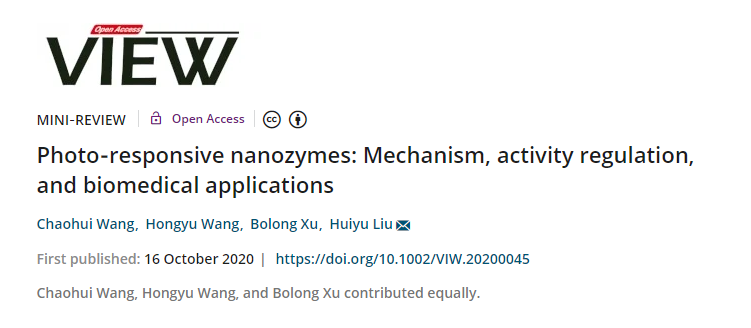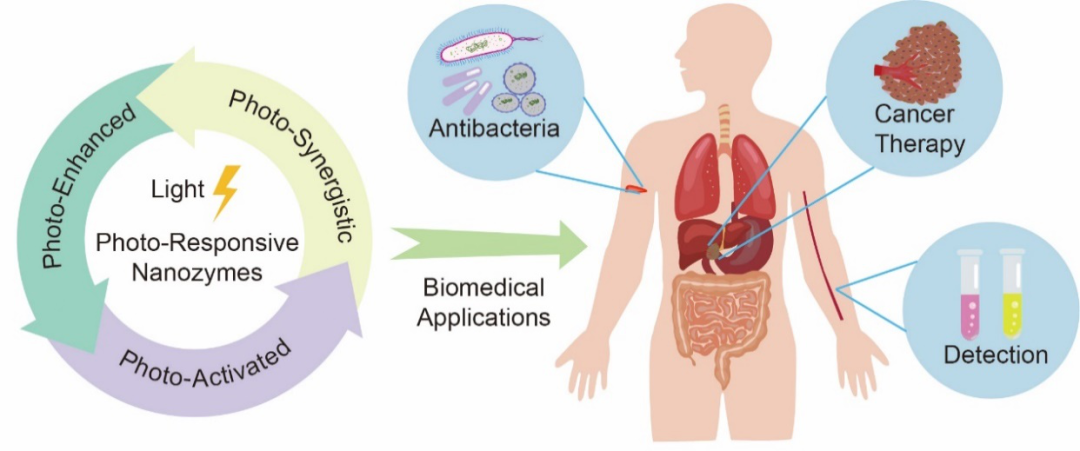The catalytic mechanism, activity regulation strategy and biological application progress of light-responsive nanozymes
QQ Academic Group: 1092348845
Detailed

Natural enzymes are biological catalysts with diverse functions. Due to their high catalytic activity and substrate specificity, they have been widely used in various fields. However, the high cost of preparation and purification, low stability and difficulty in recovery greatly limit the further application of natural enzymes. Nanoenzyme is a new generation of artificial enzyme mimics with both natural enzyme catalytic ability and unique properties of nanomaterials. It has the advantages of high stability, low cost and easy scale preparation. Since the research team of Academician Yan Xiyun first reported the inherent peroxidase-like activity of Fe3O4 nanoparticles in 2007 (Nature Nanotechnology 2007, 2, 577–583), the field of nanoenzymes has developed rapidly, and nanomaterials with different types of enzyme activities have been Extensively explore, such as precious metal nanomaterials, semiconductor nanomaterials, carbon nanomaterials and metal organic framework materials.
In recent years, the unique optical properties of these nanomaterials have also become the focus of attention of researchers, such as tunable band gap, unique absorption spectra and local surface plasmon resonance. Researchers can combine the optical properties with the enzyme-like activity of nanoenzymes to prepare a series of nanoenzymes that exhibit superior optical activity and enhance the application effects of nanoenzymes. For example, by using the photothermal properties of nanomaterials to enhance the catalytic activity of nanoenzymes, a light-enhanced catalytic system can be formed; photocatalytic synergistic enzyme activities can improve the treatment/detection efficiency; in addition, using light energy to activate the catalytic activity of nanomaterials Properties can also create light-activated nanozymes. Therefore, the introduction of optical properties of nanomaterials will expand the "connotation" of nanozymes at the optical level, and provide us with new options for improving the catalytic properties of nanozymes and expanding the application fields.

Scheme: Illustration for the mechanisms and biomedical applications
of photo-responsive nanozymes.
In this regard, the team of Professor Liu Huiyu from Beijing University of Chemical Technology was invited to summarize and discuss light-responsive nanozymes, and the relevant review was published on VIEW (DOI: 10.1002/VIW.20200045). This review covers the mechanism of light-responsive nanoenzymes, activity regulation strategies and progress in biomedical applications, and points out the current problems and future development prospects of light-responsive nanoenzymes in clinical applications. This review will provide certain guidance for the design and application of nanoenzymes.
Original link:
https://onlinelibrary.wiley.com/doi/10.1002/VIW.20200045
Information source: VIEW Zhi Kan
This information is from the Internet for academic exchanges. If there is any infringement, please contact us and delete it immediately
- Previous: Battery interface opti
- Next: A Rising 2D Star: Nove


 Academic Frontier
Academic Frontier
